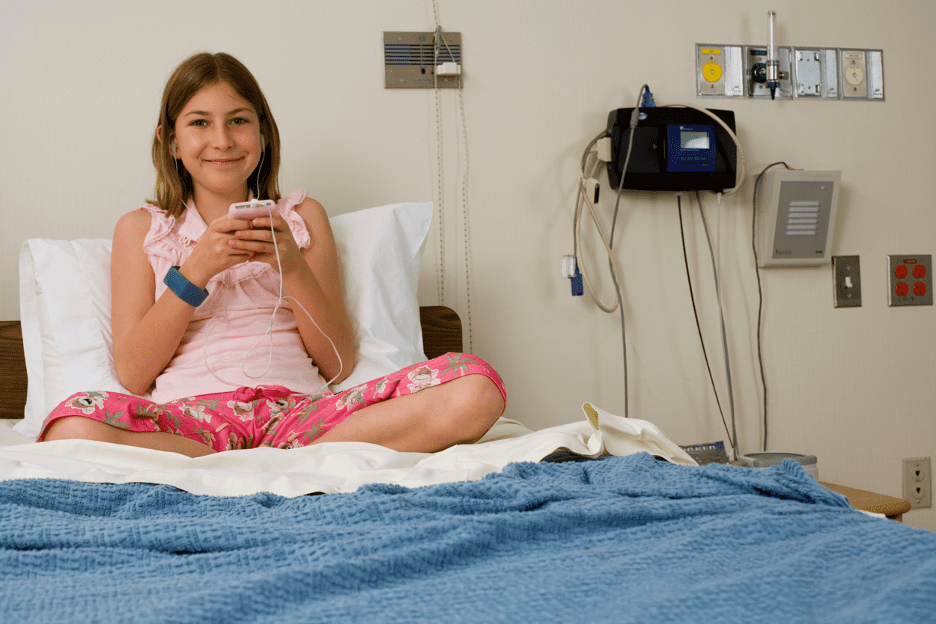Today’s hospital experience is evolving. While clinical outcomes remain a top priority, hospitals are increasingly recognizing that the emotional and psychological well-being of their patients plays a critical role in recovery. This shift has brought greater attention to the importance of a modern, well-rounded patient entertainment system that supports distraction, comfort, and engagement right from the hospital bed.
Gone are the days when a standard TV and a few channels were enough. Today’s patients, especially those facing long or complex stays, expect a digital experience that mirrors the entertainment and connectivity they enjoy at home. That means streaming, games, communication tools, and therapeutic content all in one easy-to-use solution.
A patient’s hospital stay is often defined by waiting. Waiting for results, rounds, procedures, and healing. These gaps can leave individuals feeling anxious, disconnected, and even helpless. An advanced patient entertainment system serves as more than a distraction; it becomes a tool to empower, inform, and comfort.
Hospitals that integrate smart entertainment tools into the patient experience are better equipped to manage the emotional toll of care. Whether patients are recovering from surgery, undergoing long-term treatment, or simply waiting for test results, interactive platforms offer a sense of control and normalcy that promotes healing.
A New Era of Patient Engagement
Hospitals are no longer just places of treatment; they are temporary homes, often for vulnerable individuals navigating pain, uncertainty, and stress. And while medical staff deliver exceptional care, moments of boredom, anxiety, or isolation can still creep in between visits, check-ins, or procedures.
That’s where the right patient entertainment system can make a difference. Designed specifically for healthcare settings, these systems provide a holistic experience tailored to support mental wellness and emotional connection during a hospital stay.
Modern patient engagement isn’t just about content delivery; it’s about building trust, reducing fear, and helping patients feel seen and supported. When patients feel emotionally safe, they’re more likely to comply with care plans, ask questions, and participate actively in their treatment journey.
An interactive system that combines entertainment, education, and communication enhances the overall patient experience while also lightening the load on care staff. Families, too, benefit from knowing their loved ones are being supported emotionally as well as clinically.
Traditional Entertainment Isn’t Enough
When Sentrics first introduced the concept of patient room televisions in the late 1980s, the idea was no less than revolutionary. Many hospitals still rely on those very outdated TV systems and equipment even as technological capabilities have rapidly evolved over years. As a result, hospitals’ old legacy systems have become outdated, costly to maintain and insufficient to meet the demands of today’s consumer-patients. Common issues include:
- Traditional patient TVs offer minimal functionality
- Analog TVs lack internet capability
- Outdated hardware and wiring lead to excessive service calls, maintenance staff time to fix, and TV downtime that makes for unhappy patients
- Patients have limited access to the modern media and communication tools they use every day
Today’s patients are bringing a digital lifestyle with them. In fact, seniors now bring an average of 7 to 10 internet-connected devices into senior living communities, highlighting the growing demand for smart, connected environments across all age groups.
To meet these expectations, hospitals must evolve. A modern patient entertainment system should offer more than TV; it should create a seamless experience that enhances comfort, reduces anxiety, and supports overall well-being.
The risk of ignoring these changes isn’t just patient dissatisfaction; it’s falling behind industry standards. As patient-centered care becomes the benchmark for quality, systems that can’t integrate with EMRs, enable streaming, or allow two-way communication are a liability.
Legacy systems require costly hardware upkeep and manual processes that drain IT and facilities teams. These resources could be redirected toward higher-value tasks with a centralized, cloud-based entertainment and engagement platform.
Why Hospitals Are Upgrading to Smart, Interactive Systems
Upgrading to a smart patient entertainment system is more than a tech upgrade—it’s a strategic investment in the patient experience. With the right platform, hospitals can:
Enhance emotional wellness through entertainment
Long hours alone in a hospital bed can leave patients bored and discouraged. Movies, games, music, and relaxing visuals help create a sense of normalcy and even joy.
Engagement features encourage emotional balance by breaking up the monotony of hospital life and providing meaningful diversions. These tools are especially beneficial for pediatric, oncology, or geriatric patients who face prolonged stays.
Reduce anxiety and improve comfort
Distraction-based tools, such as calming music, ambient noise controls, and guided therapy videos, can help reduce stress and support healing.
Sensory-friendly programming and interactive wellness options give patients something positive to focus on, helping regulate blood pressure, heart rate, and mood during high-stress moments.
Support cognitive engagement
Brain games, puzzles, and educational content can stimulate mental activity, particularly beneficial for seniors or long-term patients.
Keeping the mind active is a crucial part of whole-person healing. Cognitive engagement through light gamification or daily brain challenges also helps prevent delirium in older patients and promotes a sense of progress.
Enable social connection
Built-in video calling or messaging tools allow patients to stay connected with family and friends, even when visits aren’t possible.
Loneliness is a major risk factor for health decline, especially in hospitals. A smart platform with video chat, social media access, and messaging apps allows patients to maintain relationships that support recovery.
Provide health education and orientation
Hospitals can share on-demand health content, orientation videos, and post-treatment instructions, empowering patients to better understand their care journey.
Upgrading to modern systems is the key to beating patient boredom and getting them more engaged in their treatment. A Samsung study found that hospitals that use a patient entertainment system reported better patient satisfaction and health outcomes, and decreased hospital readmissions.
Patients are more likely to follow discharge instructions and participate in their care when information is delivered through familiar, interactive formats. Video tutorials and real-time FAQs simplify complex instructions and reduce nurse call volume.
The Benefits of a Purpose-Built Patient Entertainment System
Sentrics’ E3 Patient Engagement platform delivers a powerful and integrated approach to patient comfort, interaction, and satisfaction. More than just a TV, this solution turns the in-room experience into something memorable, empowering, and healing.
Key features include:
- HD television and streaming services
- Games, wellness apps, and interactive media
- Virtual therapy sessions and music programming
- Secure access to medical content and discharge instructions
- Video calls and communication tools that help patients feel less isolated
- Customizable interfaces tailored to your hospital’s brand and patient population
What sets Sentrics apart is its deep understanding of the hospital environment. Every feature is designed with flexibility, accessibility, and simplicity in mind, making it easy for staff to implement and easy for patients to use.
Administrators can push real-time updates, menus, and announcements, while clinical teams can use the system to reinforce care plans, collect satisfaction data, and reduce call button overuse. It’s a platform that connects technology with compassionate care.
By creating a more personalized and engaging environment, hospitals can improve patient satisfaction scores, reduce anxiety levels, and ultimately drive better outcomes.
Ready to Elevate the Patient Experience?
The expectations of today’s patients are clear: connection, engagement, and comfort matter. A smart, interactive patient entertainment system is no longer a luxury; it’s a necessity for modern healthcare environments looking to put the patient first.
With Sentrics, you can upgrade your hospital rooms into immersive care environments that entertain, educate, and connect. Contact us to schedule a demo or request a quote.
Updated: September 2025



